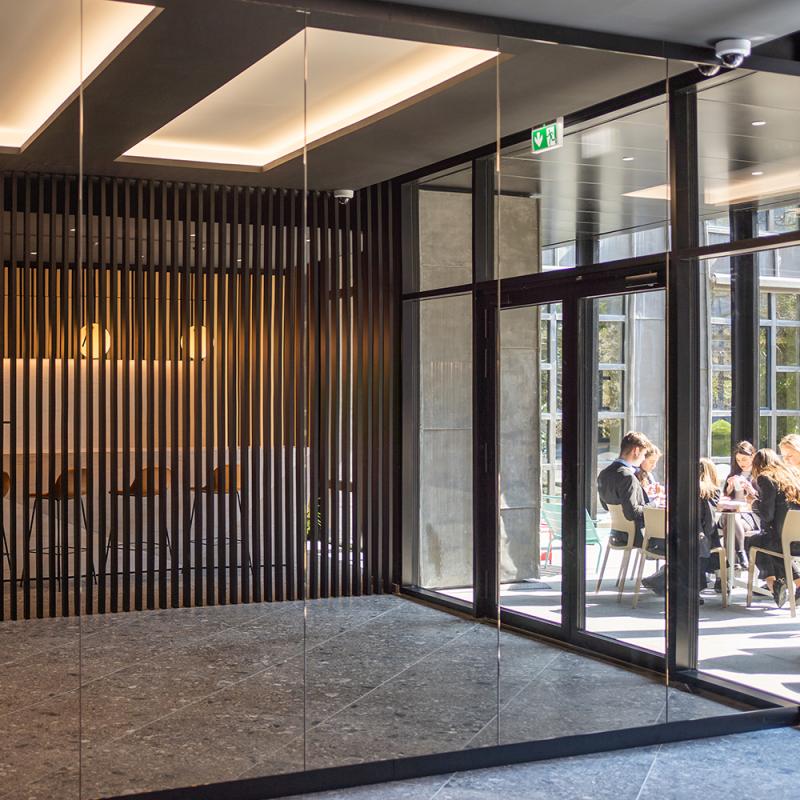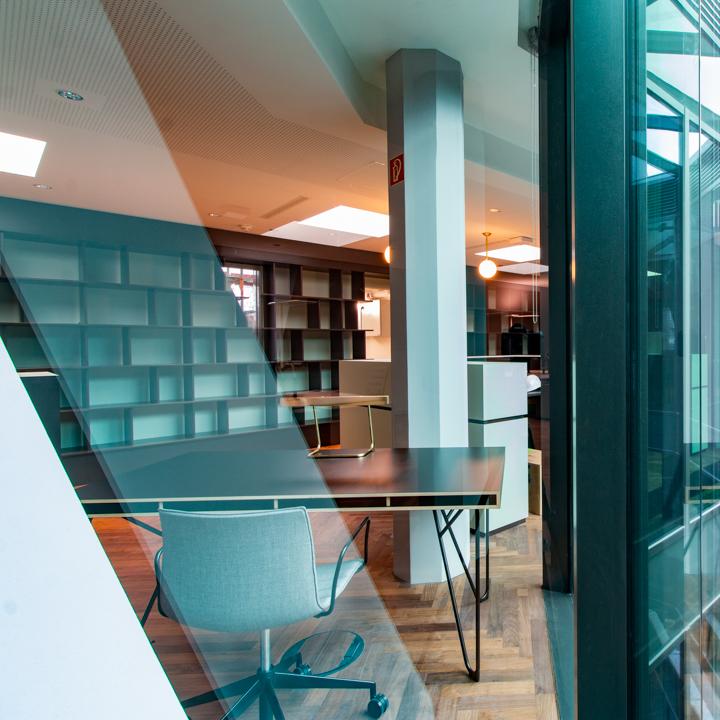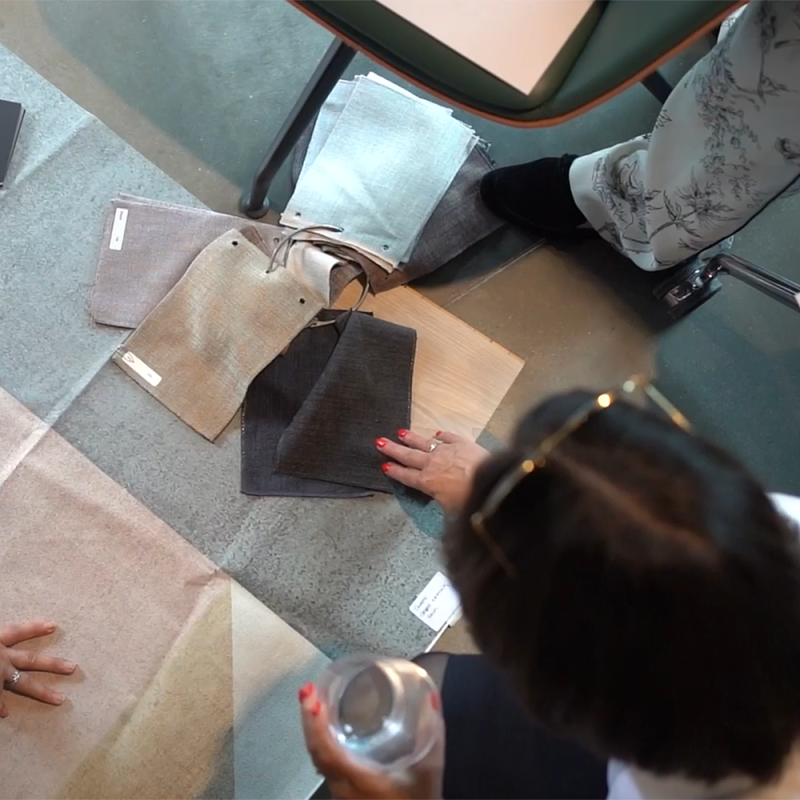Related Content

Linklaters München

The way we work is undergoing a major transformation, even in the legal world: Novel approaches to work and growing recruiting challenges have made workplace design more relevant than ever at today’s law firms. In the following whitepaper, CSMM has consolidated the insights from a series of reference projects as a leading consulting and design firm in workplace design and office architecture. The key issues for CSMM are: How do we create innovative workplaces for the legal profession and what will the typical workday look like for the lawyers of the future?
Over the past ten years, CSMM has completed more than 28 projects on behalf of several international law firms in cities across Europe, including several follow-up commissions to roll out a new corporate identity across all branch offices. This involved a series of studies and surveys with stakeholders of varying ages, positions and lengths of service. Malte Tschörtner, Managing Partner at the international architecture consulting firm, is one of the leading experts researching how novel workplace models impact the day-to-day operations of law firms, and that impact that has only become stronger in our post-pandemic world. The biggest takeaway, in his words, is clear: “Every lawyer – whether they are partners, counsels or associates – will have less office space at their personal disposal. Workplace design has an entirely new set of objectives for law firms today: flexibility, agility, serendipity and collaboration.”
These novel concepts are not only aimed at rethinking the traditional work ethic; for the very first time, they are putting the interests of the people who work there at the centre of the design. “In modern law firms, workplace design is all about giving staff a sense of belonging, putting people on equal footing and embodying the firm’s values.” In this whitepaper, Tschörtner provides a blueprint to help law firms prepare for the new world of work. CSMM outlines the prospects and opportunities for future law firms in the new work order.
The changing world of legal work: Say goodbye to the private office?
Thesis 1
Regardless of their age or position within the hierarchy, more and more employees want modern multi-purpose offices designed for dynamic and flexible use. Private offices still play a central role in the day-to-day work of lawyers, at least in continental Europe, but it is our job to reimagine these traditional spaces to meet the increasingly complex demands of the profession moving forward. At the Hamburg branch of the firm Norton Rose Fulbright LLP (NRF), which is located in the listed landmark known as the “Springer Quartier”, CSMM designed a workplace that gives everyone on staff, including partners and associates, the option to choose whether and when they work as a team or in isolation. “There are several smaller, standard-sized private offices that anyone on staff can reserve through the booking app,” Malte Tschörtner explains.
It is a similar story at the branch offices of DLA Piper LLP in Germany and abroad, which also feature CSMM’s designs. According to Managing Director of DLA Piper for UK and Europe Jan Geert Meents, today’s partners are more open to flexible spaces, moving away from the idea that a big office or fancy furniture is a sign of professional status. “Giving staff more flexibility in terms of where they work has definitely had an impact on the configuration of our offices,” Meents explains. “Whether they are new recruits or veterans, all of our lawyers stand to benefit from the pleasant work environment as well as the productive exchange that takes place in the collaborative and open-plan spaces we prioritise today.” Dr. Carsten Loll, Partner at Linklaters LLP, agrees. In Linklaters’ new Munich offices, CSMM significantly reduced the number of private offices in favour of shared, co-working spaces. Carsten Loll sees this as an essential step towards improving communication and collaboration within the firm’s teams: “It is vital to have common areas and transaction rooms for people to work together on projects and contracts or to take conference calls as a team. These changes have also helped us streamline our workflows and make efficiency gains.”
A diversity of spaces at law firms can boost productivity, loyalty and commitment
Thesis 2
Creating an innovative workplace can breathe new life into legal teamwork. With a smart mix of sizes and purposes, diverse spaces promote communication and creativity at law firms, whether staff is collaborating as a team or meeting with clients.
We are seeing more features like glass partitions, cross-team collaborative spaces, spacious lounges and communal staff canteens with outdoor seating in today’s law firms. This guarantees confidentiality within the litigation process, while also making the work environment more inspiring, more modern and a lot freer than the traditional mix of private offices and conference rooms. Co-workers also have more opportunities to interact outside of their own teams, encouraging a greater sense of community and belonging. The client areas are still designed to visually represent the firm’s corporate branding, much like a three-dimensional business card, but today they are much more informal. In staff areas, open-plan offices with flexible modular spaces dominate. Staff can configure the various collaborative spaces with modular furniture in a flexible way to encourage informal encounters and deep concentration teamwork – a real departure from the old corridors lined with private offices. At Norton Rose Fulbright LLP, for example, the open-plan office has phone boxes for telephone conversations, while many firms also deploy state-of-the-art IT equipment for targeted noise control built to the latest acoustic standards.
The digital transformation and the recent pandemic have made working from home much more common in today’s law firms. But if they want the return to the office to succeed, the firms will have to offer staff the right kind of environment. Communal social spaces are becoming ever more relevant in the legal profession, as in many other sectors. This was high on the list of demands for Norton Rose Fulbright LLP when CSMM redesigned their offices: “Libraries and spacious staff lounges are becoming major priorities, particularly as more and more staff work from home,” explains Tschörtner. “Creative spaces designed to encourage informal interaction are a key motivating factor for staff returning to the office, along with the law firm’s IT infrastructure.”
At Herbert Smith Freehills LLP (HSF), successfully creating environments for the new world of work plays a key role in the over-arching change process at this leading international corporate law firm. HSF’s Building Services Manager Stuart Moles is convinced that moving away from a traditional workplace with mainly private offices and towards a partially open-plan office with separate collaborative spaces is actually changing the way staff work. “Collaborating and communicating with staff on site is a vital part of our work. If we do not involve everyone in the development of the workplace design, how can we expect them to accept the changes to the workflow that come with it?” Moles asks, crediting CSMM for their support during the change process. “CSMM is helping HSF master all these changes, which will determine the success of the move.” The focus of the design is to offer a diversity of options and ensure that the staff use the space as efficiently as possible. “We hope that introducing collaborative workspaces, cleverly designed break rooms and high-tech client areas will be a welcome change for employees as well as clients,” Moles continues.
Challenge: employer branding at law firms
Thesis 3
Workplace design can help build a sense of belonging with the employer – not only in law firms. As competition for talent remains fierce within the legal profession and elsewhere, the “look and feel” of the office is an increasingly important factor in corporate branding today. After all, the office is where employees spend a majority of their working life. What kind of employer branding is most effective in the recruiting process? Today’s candidates want to really get a sense of a firm’s workplace dynamics, development opportunities, culture of integrity and community spirit.
The experts at the “2021 Changing Lawyer Virtual Summit” outlined just how essential a high-tech environment is for successful legal practice. This online event, which took place in November 2021 and featured presentations by legal experts from across the world, sparked a lot of interesting discussions and validated one of CSMM’s core insights. According to Tschörtner, “It’s our job to design offices as a place where staff can both collaborate and concentrate, where they can reach their full potential. In other words, the office has to provide maximum added value relative to any other place of work. The key to satisfying these ambitious demands is designing multi-purpose, flexible spaces.”
Ultimately, for law firms, as for companies in many other sectors, the main objective is a corporate office that gives employees a sense of belonging and strikes the right balance between creating an innovative office culture and preserving the firm’s rich traditions. And the latter is more important to young lawyers than we might think[JB1] . Jan Geert Meents from DLA Piper agrees: “Having the right spaces for modern workflows and processes often play an important role in an applicant’s decision for or against a prospective employer.”


Digital planning tools for modular workplace designs
Thesis 4
Today, more than ever, innovative workplace design relies on digital planning tools to develop an agile work strategy. CSMM uses the cloud-based web application spaciv to develop office layouts that are infinitely scaleable. Once the architects finalise the corporate design, the software is flexible enough to adapt the design for the individual requirements of each partner. Using the digital software ensures that the firm’s brand signature is recognisable in every office and helps designers deliver smart space planning.
The partners of a law firm are instrumental in establishing the corporate brand. And yet, given the variety of demands and desires of individual partners, that can prove challenging when it comes to designing the workplace. “spacivproduces digital interior design concepts based on modular templates, which CSMM, as solutions partners, are co-developing with the PropTech start-up. These modules can help law firms create a uniform corporate identity without neglecting the individual needs of the partners,” explains Malte Tschörtner. The software capitalises on the technical skills of CSMM’s experts as well as their long successful track record in workplace design. When our law firm clients invest in this approach, they benefit in terms of speed, flexibility and very detailed designs. This tool might just be the future of sustainable space planning: software that calculates a firm’s requirements in terms of space and layout, and then adjusts them continuously and efficiently. As a result, designers always have the latest specifications to hand and can focus their efforts on optimising the execution to align with the overall strategy and translating the data-driven insights into a real-world workplace. According to Tschörtner, “With our ‘spaciv for Law Firms’ module, we are already helping our first law firm clients take their first steps with digital space planning.” And there are many more pilot projects in the pipeline.
Lawyers are parents too! Playful workplace design at law firms
Thesis 5
More and more law firms want a workplace that allows parents to spend more time with their children without reducing their billable hours. By designing their offices with a better work-life balance in mind, law firms are shifting the focus more towards the people, their well-being and their productivity.
The Playful Principle is a trending topic today, in terms of both interior design and architecture. It is based on the premise that play can improve our mental and physical wellness. It is also the driver for the so-called playful spaces we see cropping up in many law firms today. These are spaces where mothers, fathers and children can reap the rewards of being and playing together. To name one example, CSMM designers and architects created a naturally protected environment for mothers who are still breastfeeding at the law offices of Linklaters LLP. And whether it is basinets or foldable changing tables, this corporate law firm provides the right environment for parents to manage their own infants’ care. CSMM is also developing another pilot project for the firm: “We are currently working on creating a kid-friendly space where children are free to move around when their childcare falls through at short notice,” Malte Tschörtner continues. “These spaces represent a paradigm shift in the workplace culture at law firms. It is a first step towards helping employees balance work and family more effectively as well as a massive opportunity – given the highly competitive labour market – to achieve first-mover status in an area that has so far been largely ignored.”
Law firms play a key role in revitalising the existing building stock in our city centres
Thesis 6
Through targeted modernisation of their offices, law firms are catalysts for improvements in the city-centre building stock. Their innovative revitalisation and modernisation projects add significant value to urban architecture and make an important contribution to sustainable urban development.
Malte Tschörtner applauds the decision of firms like Linklaters LLP and DLA Piper LLP to revitalise their office buildings in downtown Munich. "Law firms have proven themselves to be key drivers of modernisation, calling the owners of their properties to account as well. After all, when one tenant wants to upgrade their offices, it often requires the renovation of the entire building.” Law firms have high standards when it comes to quality, location and longevity, which often translates into above-average returns for owners. Forward-looking renovation solutions can significantly increase the value of a property, particularly when it is designed to accommodate a variety of future uses. “Architectural upgrades like this massively benefit the cityscape,” Tschörtner elaborates. “Our cities are full of derelict retail properties. Law firms play a valuable role in preserving the existing building fabric and deploying sustainable construction methods to transform it into contemporary architecture for modern use. That is a great deal better than demolishing old buildings and building new ones.”
One thing we should not underestimate, according to Dr Jan Geert Meents at DLA Piper LLP, is that locating your law firm in a prestigious property in the city centre is good for employer branding as well. “A sought-after location, the prestige of a property and the workplace design are definitely vital for the new generation of lawyers – these days, hardly anyone decides for or against an employer purely based on salary.” CSMM is currently developing a pioneering design for Linklaters’ Munich office, renovating the entire building and designing the architecture and the interiors. Linklaters Partner Dr Carsten Loll also underscores the power of corporate branding as a significant recruiting factor:“A modern office in a desirable location is at the top of the wish list for new recruits.” Taking the decision to revitalise an existing building has been a win/win for the firm: “As the single tenant, we have the benefit of spacious offices as well as underground parking, a canteen and an interior courtyard – features that we probably would not have been able to achieve in a new build.” This property has enabled CSMM to pair the advantages of modern space planning with the firm’s rich traditions. “It was important for us to preserve the historic offices that have been synonymous with Linklaters for 40 years,” Loll highlighted. The staff really appreciate efforts like this as well. Similarly, the sustainability factor is becoming an increasingly attractive asset in terms of employer branding. After all, the new generation of lawyers consider wellbeing, prestige and a sense of belonging as a top priority – and the offices themselves should reflect that.
Media contact
hicklvesting
Contact: Nicole Vesting
Kurfürstenplatz 6, 80796 München
Tel: +49 (0)89 45 23 508-11
Fax: +49 (0)89 45 23 508-20
E-Mail: nicole.vesting@hicklvesting.com
CSMM – architecture matters
Contact: Nina Eisenbrand
Werk 3, Atelierstraße 14, 81671 München
Tel.: +49 (0)89 960 15 99-0
Fax: +49 (0)89 960 15 99-99
E-Mail: marketing@cs-mm.com